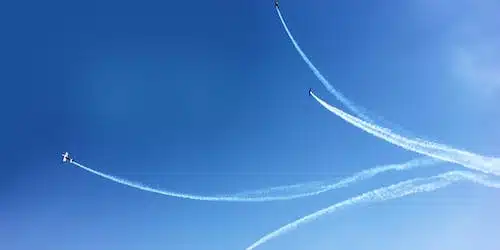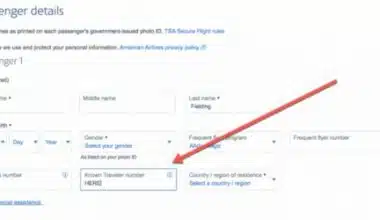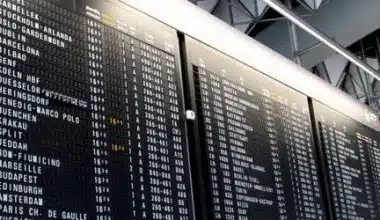The speed at which airplanes travel through the skies is a fascinating aspect of aviation. Airplanes fly at various speeds based on factors like altitude, weather conditions, and aircraft type. The different types of speeds listed below help maintain control, balance fuel consumption and travel time, and ensure smooth touchdowns. Pilots must control their speed during landing to avoid structural failure. Read on to learn more about how fast an airplane goes, whether before takeoff or in the air.
How Fast Do Airplanes Go?
Airplanes can fly at different speeds depending on various factors, such as altitude, weather conditions, and aircraft type. Many airplanes fly by generating lift and thrust. The engines of an airplane are designed to move it forward at high speed, which makes air flow rapidly over the wings.
Different Speeds at Which Airplanes Fly
Airplanes can fly at various speeds depending on their type, purpose, and operating conditions. Here are some of the different speeds at which airplanes fly.
#1. Stall Speed
Stall speed is the minimum speed at which an airplane can maintain a level of flight. It varies depending on the aircraft’s configuration and load factor. Stall speed is crucial for pilots to understand, as it helps them maintain control and prevent stalling during takeoff and landing. Commercial airplanes can fly at speeds ranging from 550 to 580 miles per hour.
#2. Cruising Speed
Cruising speed is the speed at which an airplane typically operates during normal flight conditions. It is the most efficient speed for the aircraft, balancing fuel consumption and travel time. Cruising speeds can vary significantly depending on the type of aircraft. Commercial airliners cruise at speeds between 400 and 600 miles per hour (mph).
#3. Supersonic Speed
Supersonic speed refers to speeds greater than the speed of sound, which is approximately 767 mph at sea level. Military aircraft and some experimental aircraft are able to achieve this. NASA conducts supersonic flight experiments using modified aircraft called X-planes.
#4. Takeoff Speed
Takeoff speed is the minimum speed required for an aircraft to become airborne during takeoff. It varies depending on factors such as aircraft type, weight, runway length, and weather conditions. The takeoff speed of most commercial planes is roughly 160 to 180 miles per hour.
#5. Landing Speed
Landing speed is the speed at which an aircraft touches down on the runway during landing. Commercial airplanes land at approximately 150 to 165 miles per hour. Pilots must carefully control the aircraft’s speed during landing to ensure a smooth and safe touchdown.
#6. Maximum Speed
Maximum speed, also known as the never-exceed speed (VNE), is the highest speed at which an aircraft is designed to operate safely. Exceeding this speed can lead to structural failure and is strictly avoided. Maximum speeds vary depending on the aircraft type and design.
#7. Climb Speed
Climb speed is the speed at which an aircraft ascends during takeoff or climbs after takeoff. It is higher than the cruising speed and allows the aircraft to gain altitude efficiently. Climb speeds vary depending on the aircraft’s weight, engine power, and climb rate requirements.
#8. Approach Speed
Approach speed is the speed at which an aircraft approaches the runway during landing. It is lower than the landing speed and allows the pilot to maintain control and make a smooth touchdown. Approach speeds vary depending on factors such as aircraft type, weight, and landing configuration.
#9. Maneuvering Speed
Maneuvering speed, also known as the maximum structural cruising speed, is the speed at which an aircraft can safely perform full control deflections without risking structural damage. It is lower than the maximum speed and ensures that the aircraft remains within its structural limits during maneuvers.
#10. Minimum Control Speed (VMC)
Minimum Control Speed is the lowest speed at which an aircraft can maintain controlled flight with one engine inoperative (such as during an engine failure). It is a critical speed for multi-engine aircraft and is important for pilots to know to maintain control during emergencies.
How Fast Do Airplanes Go To Take Off?
The speed at which airplanes take off varies depending on several factors, such as the aircraft’s weight, configuration, and weather conditions. The takeoff speed for commercial airplanes is between 130 and 180 mph (140 and 156 knots), depending on the aircraft and weather conditions.
Things That Affect How Fast Airplanes Take Off
#1. Direction of Airflow
The direction and intensity of the airflow affect the speed required for takeoff. Airplanes need sufficient airflow over their wings to generate lift and become airborne.
#2. Runway Length
The length of the runway available for takeoff affects the speed at which an airplane can become airborne. Longer runways allow aircraft to reach higher speeds before taking off, while shorter runways may require higher takeoff speeds to achieve the necessary lift.
#3. Runway Surface Conditions
The condition of the runway surface, such as wet or icy conditions, affects the friction between the aircraft’s tires and the runway. Poor runway conditions may require higher takeoff speeds to ensure sufficient traction and prevent skidding.
#4. Elevation and Temperature
Higher elevations and higher temperatures can affect the density of the air, which in turn affects the performance of the aircraft. At higher elevations, the air is thinner, requiring higher takeoff speeds to generate enough lift. Similarly, higher temperatures reduce air density, necessitating higher speeds for takeoff.
#5. Aircraft Configuration
The configuration of the aircraft, including the position of flaps and slats, affects the takeoff speed. Extending flaps and slats increases the wing area and changes the airflow, allowing the aircraft to generate more lift at lower speeds.
#6. Engine Thrust
The power and thrust generated by the aircraft’s engines play a significant role in determining the takeoff speed. More powerful engines can propel the aircraft forward at higher speeds, reducing the distance required for takeoff.
#7. Weight and Balance
The weight and balance of the aircraft impact the takeoff speed. Heavier aircraft require higher speeds to generate enough lift to become airborne. Proper weight distribution is also crucial for maintaining stability during takeoff.
#8. Weather Conditions
Weather conditions, such as wind speed and direction, can affect the takeoff speed. Headwinds can increase the effective airspeed, allowing the aircraft to take off at lower ground speeds. Conversely, tailwinds can reduce the effective airspeed, requiring higher ground speeds for takeoff.
#9. Aircraft Type
Different types of aircraft have varying takeoff characteristics. Larger commercial aircraft, such as Boeing 747s, require higher takeoff speeds due to their size and weight. Smaller aircraft, like Cessna 172s, have lower takeoff speeds.
#10. Aircraft Shape and Wings
The shape of an airplane, especially its wings, plays a crucial role in determining the takeoff speed. The wings generate lift as air flows over them, allowing the aircraft to become airborne. The design of the wings, including their size, shape, and wing flaps, affects the amount of lift produced at different speeds.
How Fast Do Airplanes Go In The Air?
Airplanes have a cruising speed between 550 and 600 mph, while the average ground speed is around 880–926 km/h. The takeoff speed varies between 130 and 180 mph, depending on the aircraft and weather conditions. Landing speeds range between 130 and 160 mph, largely influenced by the aircraft’s weight.
Kinds Of Airplanes And Their Levels Of Speeds
Different airplanes have varying speeds depending on their design, purpose, and operating conditions. Here are some examples:
#1. Commercial Airplanes
Commercial airplanes, such as Boeing 747s or Airbus A380s, typically cruise at speeds ranging from 480 to 560 miles per hour (mph) These speeds allow for efficient travel over long distances.
#2. Supersonic Aircraft
Supersonic aircraft, like the Concorde (no longer in service), were capable of flying at speeds greater than the speed of sound. The Concorde had a cruising speed of around Mach 2, or roughly 1,354 mph.
#3. Military Jets
Military jets, such as the F-16 Fighting Falcon or the F-22 Raptor, can reach speeds exceeding Mach 2. These high-performance aircraft are designed for rapid acceleration and maneuverability.
#4. Business Jets
Business jets, like the Gulfstream G650, can reach cruising speeds of around 560 mph. These aircraft are designed for private or corporate use and offer faster travel compared to commercial flights.
#5. General Aviation Aircraft
General aviation aircraft, including small propeller-driven planes like the Cessna 172, typically have cruising speeds ranging from 100 to 200 mph, depending on the specific model and engine power.
#6. Cargo Planes
Cargo planes, such as Boeing 747-8F and Antonov An-124, transport goods at speeds ranging from 550 to 650 mph (885–1,046 km/h), making them as large as commercial jetliners.
#7. Regional Jets
The Embraer E175 and Bombardier CRJ700 are regional jets used for shorter-haul flights within a region, with a typical cruise speed of 500 to 600 mph (805–965 km/h).
8. Helicopters
Helicopters, powered by Bell 206 JetRanger and Sikorsky UH-60 Black Hawk, can hover and serve various purposes such as transport, medical evacuation, and military missions, with speeds ranging from 130 to 190 mph.
#9. General Aviation and Sport Aircraft
The Piper Cub and Cessna 172 Skyhawk are aircraft used for training and recreational flying, with speeds ranging from 85 to 150 mph.
#10. Experimental and Record-Breaking Aircraft
The North American X-15 and ThrustSSC aircraft have set record-breaking speeds, reaching Mach 6 (4,520 mph or 7,274 km/h) and breaking the sound barrier on land, respectively, designed for research, testing, and setting speed records.
How Fast Do Airplanes Go Mph?
Aircraft have varying speeds based on factors like altitude, weather conditions, and aircraft configuration. Commercial airlines like Boeing 747 and Airbus A380 have cruising speeds ranging from 550 to 600 mph. Supersonic aircraft like the Concorde have speeds around Mach 2, while military jets like the F-16 Fighting Falcon can reach speeds exceeding Mach 2. Business jets like the Gulfstream G650 can reach speeds of around 560 mph.
Factors That Influence The Speed Of An Airplane
There are several factors that affect the speed at which airplanes can fly. Here are some factors that can limit how fast airplanes go:
#1. Aircraft Design
The design of an aircraft, including its aerodynamics and structural integrity, plays a significant role in determining its maximum speed. Factors such as wing shape, fuselage design, and engine power affect the aircraft’s ability to achieve higher speeds.
#2. Engine Power
The power and efficiency of an aircraft’s engines impact its speed capabilities. More powerful engines can generate greater thrust, allowing the aircraft to achieve higher speeds. Engine technology and performance directly influence the aircraft’s acceleration and top speed.
#3. Weight and Load
The weight of an aircraft, including its fuel, passengers, cargo, and equipment, can affect its speed. Heavier aircraft may require more power to achieve and maintain higher speeds. Additionally, the distribution of weight and the aircraft’s center of gravity can impact its stability and speed capabilities.
#4. Altitude and Air Density
Air density decreases with increasing altitude. As an aircraft climbs to higher altitudes, the air becomes thinner, which can affect its speed. Thinner air reduces the amount of lift generated by the wings and decreases engine performance, potentially limiting the aircraft’s speed.
#5. Operating Conditions
Weather conditions, such as wind speed and direction, can impact an aircraft’s speed. Headwinds can reduce ground speed, while tailwinds can increase it. Other factors, like temperature, humidity, and atmospheric pressure, can also affect aircraft performance and speed.
#6. Safety and Structural Limits
Aircraft have specific speed limits to ensure the safety and structural integrity of the aircraft. Aerodynamic forces, structural strength, and operational considerations are a few examples of the factors that determine these limits. Exceeding these limits can compromise the safety and performance of the aircraft.
#7. Aerodynamic Drag
Drag is the resistance encountered by an aircraft as it moves through the air. Various forms of drag, such as parasite drag (caused by the aircraft’s shape) and induced drag (caused by the production of lift), can limit an aircraft’s speed. Higher speeds require more power to overcome drag.
#8. Engine Limitations
Aircraft engines have specific operational limits, including maximum RPM (revolutions per minute) and temperature limits. These limitations are set to ensure the engine’s safety and prevent damage. Exceeding these limits can lead to engine failure or damage.
#9. Altitude Restrictions
Some aircraft have altitude restrictions that limit their maximum speed. These restrictions are often related to engine performance, aerodynamic factors, or operational considerations. Higher altitudes may require reduced speeds due to thinner air and decreased engine efficiency.
#10. Operational Constraints
Operational factors, such as air traffic control restrictions, airspace limitations, and noise regulations, can impose speed restrictions on aircraft. These constraints are in place to ensure safe and efficient operations within the aviation system.
How Fast Can a Normal Plane Go?
The speed of a normal plane varies based on various factors, such as aircraft type, altitude, weather conditions, and other factors. Commercial planes typically cruise at 550–600 mph, while private jets typically cruise at 500–600 mph. Military planes can exceed 1,500 mph, and single-engine planes, such as the Cessna 172, fly slower than commercial planes. The SR-71 Blackbird set a speed record of Mach 3.3, and the Concorde could fly faster than the speed of sound.
Do Planes Go Full Speed In The Air?
Planes do not fly at their maximum speed throughout an entire flight. This is because flying at maximum speed for an extended period would be inefficient in terms of fuel consumption and could put excessive stress on the engines and airframe. Air traffic control, airspace restrictions, weather conditions, and efficiency considerations all play a role in determining the speed at which planes fly. Additionally, engine and structural limitations also impose speed restrictions for safety and reliable operation.
Can A Plane Go 1000 Mph?
Some planes have reached or exceeded speeds of 1000 mph, including the Lockheed SR-71 Blackbird, Concorde, and various experimental and supersonic fighter jets. However, it’s important to note that these speeds are exceptional and not typical for commercial airlines. Commercial planes usually operate at cruising speeds ranging from 500 to 600 mph.
What Is the World’s Fastest Jet?
The Lockheed SR-71 Blackbird is considered the world’s fastest jet aircraft. It holds the record for the fastest speed ever recorded by a manned aircraft, reaching speeds of Mach 3.3, which is more than 2,100 mph. The SR-71 Blackbird was an American high-altitude reconnaissance airplane designed to outrun surface-to-air missiles and interceptors. Its unique engine inlets and design elements contributed to its exceptional speed and agility.
How Fast Is The Fastest Jet?
The fastest jet aircraft in the world is the Lockheed SR-71 Blackbird, which can reach speeds of Mach 3.3, or more than 3,500 kph (2,100 mph). The North American X-15 holds the record for the fastest manned aircraft ever produced, with a maximum speed of Mach 6.70 (about 7,200 km/h). Military aircraft can exceed 1,500 mph (2,400 km/h, 1,297 knots, 2.08 Mach). The MiG-25 Foxbat is the fastest fighter jet in the world today, with a top speed of 2,190 mph. The F-14 Tomcat, designed and built by Grumman, can reach a top speed of 1,544 mph.
Do Planes Fly Faster Into The Wind?
Planes do not fly faster into the wind. The wind can affect the ground speed of an aircraft, but it does not directly impact the airspeed at which the plane is flying through the air. A tailwind, which blows in the same direction as the aircraft’s flight path, can increase the ground speed and make the flight faster in terms of travel time. Conversely, a headwind blowing opposite to the flight path can decrease the ground speed and make the flight slower in terms of travel time.
How Can a Plane Fly So High?
Planes can fly at high altitudes due to several reasons. Firstly, jet engines, which are commonly used in modern airliners, are most efficient at high altitudes. The air at higher altitudes is thinner, resulting in less drag and friction on the plane. This allows the aircraft to fly faster while burning less fuel. Flying at higher altitudes also allows planes to avoid obstacles such as birds, drones, and light aircraft that typically fly at lower altitudes. It helps minimize air traffic congestion and maintains safe distances between aircraft to prevent collisions.
Why Do Planes Fly So Fast?
Planes fly fast due to several factors. They are designed for efficiency, with jet engines that work best at high altitudes where the air is thinner. This allows them to cover long distances quickly while using less fuel. The design and materials of airplanes also reduce drag and increase speed. Flying at higher altitudes further enhances speed by reducing aerodynamic drag and improving engine efficiency. Different aircraft types have different speed capabilities, with commercial airliners cruising around 500–600 mph. Supersonic aircraft can reach speeds up to Mach 2.
Conclusion
Commercial airplanes typically take off between 130 and 180 mph (140 and 156 knots). Airplanes have varying cruising speeds, ground speeds, takeoff and landing speeds. Aerodynamic drag, aircraft design, engine power, weight and load, altitude and air density, operating conditions, and safety and structural limitations all have an impact on an aircraft’s speed. Commercial airliners like Boeing 747 and Airbus A380 have cruising speeds ranging from 550 to 600 mph, while supersonic aircraft like the Concorde can reach Mach 2. Higher speeds require more power to overcome drag.
- HOW FAST DO CRUISE SHIPS GO?
- HOW HIGH CAN A HELICOPTER FLY? All You Need To Know
- WHAT IS A CHARTER FLIGHT? Features and Costs
- CAN YOU BRING FOOD ON AN AIRPLANE? All You Need To Know
- FRACTIONAL JET OWNERSHIP: All You Need To Know






